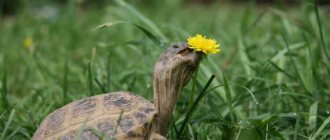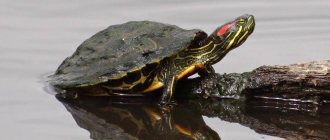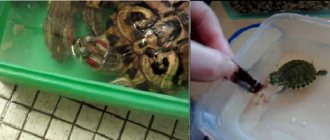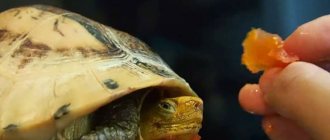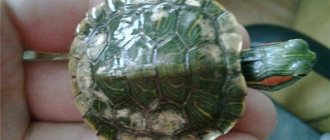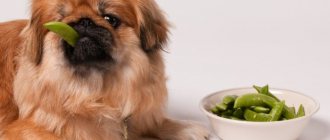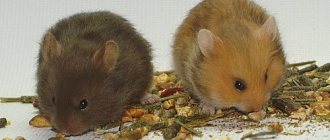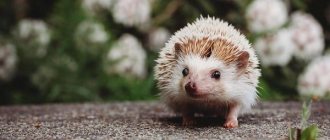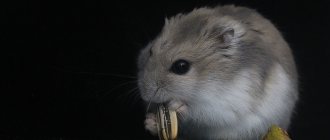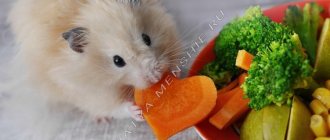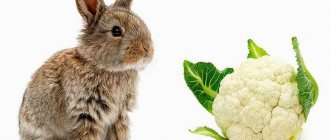- daily;
- weekly;
- monthly.
As a rule, the menu is prepared in advance, with planning for each day. This takes into account all the necessary vitamin supplements, in the form of calcium and various amino acids. If you have purchased a turtle and you don’t know how to feed it, then first you should at least do some preliminary planning of its diet. During the feeding process, it will become clear how her nutrition should be adjusted. In order not to take risks, it is better to seek information from a specialist or “rummage” on the Internet, where there is a lot of useful information.
It is very important that nutrition is optimal and balanced. The turtle should not be overfed, but it should not be allowed to starve either. Her diet should include foods rich in essential vitamins and microelements to ensure normal development and growth for the pet.
If a turtle eats a lot of different foods, this can negatively affect the health and longevity of the pet. As a result of overeating, the turtle may develop liver and gastrointestinal diseases.
If there is insufficient food, the turtle will not receive the required amount of nutrients, which can lead to developmental defects.
Although land turtles eat mainly plant foods, care should be taken to ensure that the turtle also consumes animal foods. This may not be more than 5% of the entire diet, but this is quite enough for its normal development.
Those who do not know how to feed this animal can purchase special artificial supplements with vitamins, proteins and other microelements. How many of these supplements are required to the basic diet is indicated on the packaging.
The full list of permitted plants and vegetables can be found here.
Keeping a land turtle at home
A turtle at home requires placement in an aquarium, terrarium or enclosure. There are many reasons for this. Crawling freely around the apartment, your pet may encounter such dangers as:
- dust that exists in every apartment - it can settle and accumulate on a turtle’s shell;
- bacteria that can cause various diseases;
- drafts;
- unsuitable temperature and humidity of the room where the animal crawls;
- lack of ultraviolet radiation, due to which the turtle may lack some vitamins that the body produces when exposed to sunlight;
- other domestic animals, for example, cats or dogs, and even the person himself can injure the land creature.
Types of land turtles
living on land are divided into about 300 different species , but not all can adapt to home conditions. The following types of land turtles adapt well and are distinguished by their unpretentiousness:
- Egyptian;
- radiant;
- panthers;
- Mediterranean (Caucasian or Greek);
- Central Asian steppe;
- red-footed;
- yellowlegs;
- Balkan;
- yellowheads.
Each species on this list has a high ability to adapt to different living conditions and requires the same maintenance.
Caring for a land turtle
Any land turtle needs proper care, which includes maintaining the cleanliness of its home, itself, and ensuring a proper lifestyle. So, how to care for a land turtle:
- feed regularly and variedly in accordance with one or another habitual diet;
- bathe in warm water every week - this gives land turtles great pleasure, in addition, it helps to increase appetite and good intestinal function;
- take care of the claws - in captivity they do not have time to grind down as they grow, so they need to be trimmed periodically with a special nail clipper;
- take it out for walks in the fresh air - on warm and sunny days it is very useful to give the turtle the opportunity to walk in the open air, but you need to constantly monitor it, since it can disappear from sight in the depths of the grasses in a very short time.
What to feed a land turtle?
A natural question for novice tortoise lovers is: what to feed a land tortoise at home? Their main diet consists of plant foods - berries, fruits, vegetables, grass. It is best to feed them a mixture of different ingredients - this way their diet will be varied and balanced. You can put food on a flat saucer, the main thing is that it is convenient for the turtle to eat from it. The vegetable and fruit menu in the summer can and should be diversified with clover, dandelions, sorrel, sprouted oats, and pea leaves.
Vitamins for land turtles
Vitamin and mineral supplements are desirable in the diet of land turtles kept at home. Carbonate, bone meal, ground eggshells, and glycerophosphate can be used as mineral additives. They should be given at the rate of 100 mg per 1 kg of animal weight. As for vitamins, the Central Asian domestic land turtle needs natural sources of vitamins A, B12 and D3. You should not give her oil preparations and vitamin D2. She must get everything she needs from food.
Omnivores
Despite the name, semi-aquatic and marsh turtles are the most demanding in terms of food composition. In addition, their diet can change significantly during the period of growing up.
The optimal composition of the diet depends solely on the type of turtle. In addition, it is necessary to determine how many times to feed small turtles, whose main diet consists of food of animal origin.
What to feed a land turtle?
These animals are among the most unpretentious. Turtles eat little and do not require special care - they are not difficult to keep at home. All land turtles are herbivorous reptiles. As mentioned above, their diet consists of 95% plant foods and 5% animal foods. Feeding food that is inappropriate for this group, such as meat, is fraught with diseases.
What does the turtle like?
Turtles' favorite foods are lettuce and dandelion leaves - they can even be dried for the winter. She is also partial to vegetables and fruits. The main food consists of almost all plants, vegetables, fruits, and berries that are non-poisonous to turtles. You can feed field grasses and houseplants, such as: aloe, pea stems and leaves, tradescantia, alfalfa, timothy, lawn grass, plantain, gooseberry, rhubarb, sprouted oats, barley, thistle, sorrel, coltsfoot.
The vegetable menu consists of peppers, beans, pumpkin, carrots, zucchini, radishes, beets, artichokes, this list will be supplemented by cucumber and horseradish, which should not be given in large quantities.
It is allowed to feed land turtles with a variety of fruits and berries: apples, apricots, plums, peaches, mangoes, bananas, oranges, tangerines, watermelon, raspberries, strawberries, blueberries, wild strawberries, blackberries, blueberries. Additional complementary foods include: mushrooms, dry commercial feed, dry sea cabbage, young sunflower seeds, soybean meal, bran.
What should you not give to turtles?
It is undesirable to feed onions, garlic, spinach, spicy herbs, grasshoppers, crickets, domestic cockroaches, poisonous insects, cherries, eggshells (causes salmonellosis), or feed one type of vegetable or fruit.
Prohibited foods include:
- potato,
- medicinal products containing alkaloids,
- indoor (dieffenbachia, euphorbia, azalea, elodea, ambulia, oleander, elodea.
- vitamin D2 and the drug gamavit (they are toxic to reptiles).
- milk, bread, citrus peels, seeds from fruits and berries, pet food, “human” food, including cereals (with the exception of rolled oats, which are not boiled, but soaked in water or vegetable juice, it should be given no more than once a day). month), meat, any prepared foods.
Poor nutrition causes irreversible changes in the animal’s liver, which can cause its life to be much shorter.
Errors
- Feed your reptile too often. This will cause overeating and indigestion.
- The reptile body is adapted to consume a certain type of food. You cannot feed a herbivore only meat, and a carnivore only fruits and vegetables.
- Giving your pet food too rarely. The individual will be weak, lethargic, inactive and susceptible to disease.
If you follow the rules of feeding land reptiles, they will have good health and longevity.
Sources:
https://womanadvice.ru/chem-kormit-suhoputnuyu-cherepahu-zimoy https://myturtle.ru/chem-kormit-krasnouxuyu-cherepaxu/ https://rybkies.ru/obitateli/chem-kormit-suhoputnuyu-cherepahu -v-domashnih-usloviyah.html
List of prohibited products
If you feed your turtle incorrectly, irreversible pathological processes in the liver may occur. The introduction of prohibited foods to the menu can cause the death of your pet.
Their list is very extensive. It is prohibited to give to reptiles:
- spicy herbs;
- herbs rich in alkaloids;
- onion and garlic;
- potato;
- zest;
- milk;
- cat and dog food;
- eggshells, as they can be contaminated with bacteria of the genus Salmonella;
- poisonous indoor plants (water plague, oleander, limnophila, azalea, spurge, dieffenbachia);
- domestic cockroaches, crickets and grasshoppers;
- vitamin D2, since it is poisonous;
- dishes from the owners' table: sausages, sausages, cheese, porridge (you can give rolled oats, which need to be steamed and not boiled), canned food, fried and boiled food.
Common mistakes in turtle feeding
For novice turtle owners, it is very important not to make mistakes with their pet’s diet. After all, the correct composition of nutrients is necessary for the animal to form a strong shell, as well as growth and activity. It is very important for the tortilla's body to receive calcium and vitamins.
Prohibited foods: eggs, bread and milk, as well as beans, peas, cabbage. Do not offer your turtle: tomatoes, radishes, radishes, garlic, herbs, nuts, cherries.
Turtles can usually go without food for quite a long time. But if your pet suddenly refuses the food offered, it is best to take him to the vet.
The turtle needs love too
It is very important to understand that a turtle is a living creature that requires care and attention, and not a toy that can be played with and left to the mercy of fate. If you have chosen these unique reptiles, take a responsible approach to the question of what to feed your turtle at home.
After all, the health and life of your pet depends on it. The more seriously you take the conditions of its existence, the longer the turtle will be able to please you. When buying a turtle, contact experienced sellers who can tell you what to feed a water turtle at home and what to feed a land turtle, so that later you don’t have to guess why your pet died, because you fed it.
It turns out that if a turtle is not fed correctly, it begins to be capricious, eat poorly, or even refuse food altogether. or steppe turtles are no exception. In order for your pet to feel at ease, properly structure your baby’s diet.
What to feed the Central Asian land turtle?
Let's start with the fact that absolutely all turtles love plant foods. Healthy plants include cabbage, pumpkin, watermelon, melon, lettuce, apples and dandelions. They will not refuse berries - raspberries, cherries and strawberries. Milk with white bread soaked in it will also appeal to the armored animal.
What else is possible? Calcium is necessary for building and maintaining the strength of the bone cover - the shell. Therefore, fresh cottage cheese must be present on the menu. Semolina and buckwheat porridge will usefully enrich the list of food products.
Don't think that turtles are vegetarians. They eat absolutely everything. Therefore, you need to be very careful when decorating terrariums. After all, almost everything that gets there will be “tested.” So, do not deprive your pet of protein food. One tablespoon of raw minced meat or half a hard-boiled egg is enough. But instead of feeding a domestic land turtle with meat that is harmful to it, make up for the lack of protein by replacing the product that is bad for the kidneys with a real worm, which is fed to aquarium fish. But don't overdo it. Any food of animal origin can lead to indigestion. It’s better to replenish your turtle’s kitchen with beans rich in vegetable protein.
Do not overfill your turtle's diet with tomatoes, cucumbers and carrots. They don't like them. This is easily explained, because in the wild these animals eat berries, desert plants or carrion.
What to feed a land turtle in winter?
Turtles usually hibernate during the winter. But the house is quite warm during this cold period. Therefore, the turtle does not sleep, but simply becomes slow. What should you feed your land turtle at home during this period?
Food products can be left the same. But don't be surprised if your little friend can't make it through the summer daily quota. An approximate daily diet can be calculated for the winter period, and it will look something like this:
- carrots – 30 grams,
- boiled potatoes - 20 grams,
- cabbage – 30 grams,
- white bread – 20 grams,
- fish oil - 0.5 grams,
- beets – 20 grams.
Just don’t forget to enrich this list with herbs in the summer, for example, dandelion, the leaves of which can be picked far from a busy and polluted highway and city.
Does a land turtle need to be given water?
We told you what to feed domestic land turtles. But, after all, they also need water, although they drink quite rarely: some drink it once every one to two weeks, while for others one “date” with water a month is enough. The frequency with which water treatments need to be administered depends on what the animal eats over a certain period of time. If it is cabbage, then the cells of the turtle’s body receive a sufficient amount of moisture, and you will have to “bathe” less often. But if the majority of the daily diet consists of white bread, baths should be arranged a little more often.
Although, in order not to rack your brains, give your turtle a bath day once a week or a week and a half. Pour a little less than a centimeter of water into the basin. The pet's nose must be above the water level so that the land inhabitant of our planet does not suffocate. Place the animal in the water and leave it to enjoy for half an hour. Believe me, this time is enough for the baby to have time to get drunk and take a swim.
Unfortunately, many people do not take turtles seriously enough, not like other pets, they know little about the peculiarities of keeping and caring for them, and most importantly, they have little interest in the question of what to feed turtles. But these babies also require a balanced diet, various nutritional supplements for active growth and well-being.
Sample menu and additional components
The menu for your pet should be prepared in advance so that you don’t have to worry about the lack of certain foods in the diet.
Sample menu:
- 50 g of green stems are given every two to three days.
- Beet pieces should be given. No more than 30 g per day.
- 30 g of cabbage leaves once every 1–2 days.
- Boiled potatoes in the amount of 30 g per day.
- Proteins enter the turtle's body through the consumption of bloodworms, worms, and lean meat pieces. There should be no more than 5 g per day.
- White bread – 20 g per day.
- Vitamin supplements, such as fish oil. There should be no more than 1 g per day.
- Porridge – semolina, buckwheat, cottage cheese. Do not give more than once a week.
Three groups of turtles
Based on their feeding type, turtles are divided into three groups: carnivores, omnivores and herbivores.
. Each of them corresponds to a certain ratio of animal and plant foods. Feeding inappropriate food for each group of turtles is fraught with diseases of the internal organs, digestive complications, and metabolic problems. You also need to include calcium and vitamins in your diet weekly. What food should be given to each group?
Predatory
The food of predatory turtles should consist of 80% animal food and 20% plant food. This group includes almost all aquatic species and all young aquatic ones, such as young red-eared, caiman, trionics, swamp, musky, etc.
The main food for them is:
- lean fish, live or thawed, with entrails and small bones. For young turtles, the fish should be finely chopped (spine, excluding ribs) with bones, for adults - whole or large pieces. Large bones can be ground or finely chopped.
- beef or chicken liver is given once a week;
- seafood such as green (not pink) shrimp, sea cocktail;
- mammals (small): naked mice, rat pups, runners.
The turtle can eat all seafood, as well as fish, only raw; heat-treated food should not be given;
Additional food
, which should be given once a week, serves:
- Dry food for freshwater turtles, for example, in the form of sticks, tablets, flakes, granules, capsules, Sulfur, etc.
- Insects: moth, food cockroaches, grasshoppers, bloodworms, crickets, earthworms, gammarus and so on;
- Mollusks, amphibians, invertebrates: slugs, frogs, small snails with shells, tadpoles and similar swamps.
It is prohibited to give to predatory turtles:
meat (beef, chicken, pork, lamb, sausages, sausage, any type of minced meat, etc.), as well as fatty fish, milk, cheese, bread, fruit, dog or cat food, etc.
The diet of this group of turtles should consist of 50 percent animal food
and 50 - vegetable. Omnivorous turtles include semi-aquatic and adult aquatic turtles, some types of land turtles: spiny turtles, coora turtles, adult red-eared turtles, Spengler's turtles, red-footed turtles (coal turtles), etc.
Their menu consists of half animal food, see the list above, and half plant food, the list is below. Aquatic turtles are pampered with fish
and seafood (as animal food), and mice are given to land animals.
- Plant food for aquatic species are plants growing in water conditions;
- Land animals are given plants that live on the ground, and fruits and vegetables are added to them.
Herbivores
The menu of this group of turtles is based on plant foods, which make up 95% of the total diet, animal food consists of 5%.
Herbivores include: all land turtles, including radiated, flat, Central Asian, Greek, spider and others.
The main food of this group is:
- greens, it makes up 80% of the entire menu (semi-dry or fresh salads, edible leaves, flowers, succulents, herbs.
- vegetables - 15% of the diet (pumpkin, cucumbers, zucchini, carrots...)
- fruits that are not very sweet (apples, pears, etc.) are represented in 5% of the menu.
Additional food
once a week, it includes:
- non-poisonous mushrooms, such as russula, boletus, champignons, etc.
- dry balanced food for land turtles of the brands “Sera”, “Tetra”, “Zumed”.
- other: soybean meal, dry yeast, raw young sunflower seeds, bran, dried seaweed...
It is prohibited to give meat; this category includes: any minced meat, sausages, sausage, chicken, beef, pork, etc.). Also fish, milk, cheese, cat or dog food, bread...
Food in summer and winter
Summer feeding of land turtles is usually not difficult, because fresh herbs, vegetables, fruits, and berries can be easily picked or purchased.
Food should be prepared for the winter. Greens can be cut and frozen in the refrigerator, dividing them into daily portions. You can do the same with fruits and vegetables. Forbs can also be prepared in the form of hay.
If there are fish in the house, then you can plant an abundance of aquatic plants in the aquarium and feed your land pet with them in winter.
In the terrarium you can also install clay pots in which alfalfa, oats, wheat stalks, plantain, dandelion sprouts, and cultivated varieties of greens grow. All types of land turtles happily eat sprouted carrot tops.
How and what to feed a turtle: general features
Rational and balanced nutrition
Like the diet of other pets, the diet of any type of turtle should be rational and balanced. A harmonious menu of different types of foods, including both plant and animal foods, is necessary for turtles of all types.
It is also important to ensure that these animals always have access to a shallow bowl of water, which needs to be changed daily.
Regularity of nutrition
It is important to maintain regular nutrition. An adult turtle of medium size should eat at least half a head of lettuce or at least a smaller amount of other food every day.
If your turtle eats almost nothing, you should definitely pay attention to this: it is likely that your pet is sick. It is advisable to get a scale and periodically weigh the animal, noting fluctuations in its weight, in order to promptly notice the occurrence of problems with your pet’s health.
The importance of calcium in food
It is especially important for turtles to have calcium in their food, which ensures their shell and bone strength. Since there is almost no this important element in plants, it is worth purchasing vitamin supplements containing calcium and adding them to the turtle’s food.
It is important to follow the dosage of such supplements, since excessive use will have adverse effects on the animal.
Feeding turtles at home
When wondering what to feed a turtle at home, you should first of all focus on the type of animal, depending on which the choice of rational nutrition is made.
Choosing food that is inappropriate for a particular type of turtle can lead to metabolic disorders in the animal and problems with digestion.
How to organize feeding a turtle
You can feed your turtle in different ways:
- placing food in the water of the aquarium;
- from tweezers;
- leaving food on the sushi island in the aquarium;
- outside the aquarium if you do not want to pollute the water with food debris.
It’s worth hand-feeding the turtle at first so that the animal gradually gets used to being independent and comes to you to eat on its own. It is worth accustoming to new foods gradually, and if there are several turtles, it is worth making sure that all animals get food. Turtles do not eat cold food, so food must be taken out of the refrigerator in advance and given to the animal to eat only when it reaches room temperature. It is advisable to feed the turtle during the day, when the animal is most active, or, alternatively, a couple of hours before bedtime.
Adult red-eared turtles should be fed once every few days, young ones - every day. A land turtle should be fed once every 2 days for an adult and once a day for young animals. Dry food should be consumed only as a supplement to the main food. Young individuals and females in anticipation of offspring must eat every day, and their menu must certainly include calcium and vitamin D in significant amounts in such cases.
Land turtles are the most popular species of reptile. Pets are unpretentious in keeping. Under natural conditions, turtles independently obtain their own food - food of animal and plant origin. But when buying a home, the owner of the animal takes on the responsibility of what to feed land turtles at home.
The diet of land turtles must be varied and contain all the substances and trace elements necessary for the reptile’s body.
The most popular types of land reptiles kept in people's homes among owners are:
- Central Asian (steppe).
- Mediterranean (Greek).
- Egyptian.
- Balkan.
- Musky.
- Leopard (panther).
- Elephant (Galapagos).
- Star (Indian).
- Serrated (yellow-legged).
- Red-headed flathead turtle.
- Radiant turtle.
What do wild turtles eat?
Based on the type of food, these reptiles are divided into the following three groups:
- herbivores,
- predatory,
- omnivores.
Each of the groups, naturally, has its own taste preferences, and their “rationing” must be arranged in the ratio of plant and animal components of the diet determined by nature.
Herbivores are land turtles, on the “table” of which animal food can account for only 5% of the total mass. Everything else is purely plant-based. The usual food for them is herbaceous annual plants called desert ephemerals, sprouts of perennial grasses and shrubs. Turtles eat not only fresh greens, but also dry grass, flowers, as well as seeds and fruits.
For predators - aquatic and swamp turtles - the opposite is true: if animal products on the menu should be present in an amount of 70-90%, then the remaining 10-30 percent is represented by “herbs”. In the natural environment, they eat small frogs, insect larvae, mollusks, woodlice, fish, and worms. And coastal and aquatic plants act as green food.
The diet of omnivorous amphibians consists of equal parts of all types of food - 50 to 50.
What to feed your turtle?
In the wild, the land turtle obtains its own food. These animals love to eat grass, various algae, roots, and berries. The owner's first task when keeping a reptile of this species should be to provide proper and balanced nutrition.
Note! The further condition and development of the pet will depend on a well-formulated diet.
It is important that the menu included various mineral components and vitamins that will ensure the growth of the pet.
A turtle at home should eat the following food:
- greens - clover leaves, wheat germ, leaves, dandelion flowers, coltsfoot, parsley stems and leaves, lettuce leaves, aloe;
- various vegetable crops. Amphibians are especially fond of carrot roots, cabbage leaves, green peas, beets, pumpkins, zucchini, tomatoes, and fresh cucumbers;
- Freshwater animals gobble up various types of berries for their sweet souls. To feed them you can use cherries, currants, raspberries, grapes, strawberries;
- Be sure to include a sufficient amount of fruit in your diet.
To make feeding comfortable, all hard fruits and vegetables can be cut into small pieces. Bananas and soft berries can be given whole. Before giving fruit from them, all seeds must be completely removed, otherwise the reptile may choke on them.
What else can you feed a land turtle at home? An amphibian's menu must contain protein foods. It is required to maintain vitality, active growth and development of the reptile. Protein foods include various mucus, worms, and boiled lean meat can also be given. But under no circumstances should you include various cockroaches and crickets in your pet’s diet. It is better to purchase red worms at a pet store.
Plant-based food
Plant foods are necessary for all turtles, but as they age they make up the majority of their diet.
Grass
Animals love plantain, clover, vetch, dandelion leaves and rhubarb. In addition, they can be given lawn grass, coltsfoot, sprouted barley and oats.
Fruits and berries
It is recommended to cut plums, apples, pears, bananas, peach, mango into small pieces and offer them to the turtle as a treat. Tangerine, orange, apricot and melon are also suitable for feeding animals.
Article on the topic: How often should a land turtle be fed at home, how many times a day should a pet eat
Aquarium plants
It is preferable to plant duckweed, spirogyra, water beetle, and pond algae. The turtles do not allow the plants to grow even a little - they are instantly eaten. You should refrain from planting elodea! The plant secretes poisonous sap and poses a danger to animals.
Vegetables
The diet should include bell peppers, cucumbers, tomatoes, zucchini, and eggplants. You can’t do without pumpkin, radishes, legumes, carrots and beets. Broccoli, celery, and dry seaweed are given as additional food.
Mushrooms
Pieces of boletus, champignons, and russula are recommended to be given to animals no more than once a week.
Attention!
Human food is not suitable for turtles! They will also happily eat food intended for other animals, but it will not benefit the turtles. It is forbidden to feed citrus peels or give berries with seeds.
What to feed a land turtle at home
Turtles are classified as omnivores. What does a land turtle kept at home eat? It is advisable to include not only plant foods in the diet. Twice a week you should give a turtle kept at home snails, crickets, and worms. Your pet will happily eat fresh fruits, vegetables and berries: melons, apples, tomatoes, carrots, broccoli. Always balance your turtle's diet. Some of them prefer sweet fruits, which should be alternated with other foods to ensure that their diet is full of nutrients and minerals. Leafy greens are an excellent addition to this animal's diet.
Among the favorite delicacies of turtles are:
- small fish;
- crayfish;
- crickets.
It is advisable to buy turtle food at a pet store to supplement the diet with some vitamins that they lack in captivity.
Feed your pet turtles a plant-based diet:
- clover and dandelions;
- parsley and lettuce;
- carrots and cabbage;
- raspberries and grapes;
- apricots and plums;
- bananas, apples, oranges.
By using these tasty foods in your pet's diet, you can provide her with an ideal environment in your home.
We should not forget that the turtle needs to be fed dry food (sea kale, seeds, champignons, bran, dry yeast, etc.)
Best Foods for Aquatic Turtles
Aquari-Profy
This is a granular food designed for regular feeding of aquatic aquarium inhabitants. Aquari-Profy is produced in jars of various sizes containing granules from pieces of shrimp, fish, insects, bloodworms, seaweed and other invertebrates. The food is rich in various vitamins, minerals (calcium, magnesium, phosphorus), macro- and microelements that protect the shell from softening, promote muscle growth and reproduction of the animal. The food has an excellent taste, so animals eat it with pleasure.
Biokraft
This is a dry food for terrarium inhabitants, the main ingredients of which are vegetables, grain products, small insects and chopped fish. Intended for daily nutrition, the food includes the minerals necessary to protect the shell from softening and other diseases - phosphorus, potassium and magnesium. In addition, it is enriched with substances such as proteins, carbohydrates, fats, amino acids and B vitamins. Constant feeding with this food contributes to the development of the food reflex, strengthening the immune system and the richness of the animal’s color. Animals that frequently take Biokraft do not need other nutritional supplements or vitamin complexes.
Tetra ReptoDelica Shrimps
This is a supplementary treat food for Tetra ReptoDelica “Shrimps” for carnivorous turtles. Rich in minerals – contribute to the proper development of bones and shell. Ingredients: shrimp
Tetra ReptoDelica Shrimps
Description
The low carapace (carapace) is almost oval; if you look at it from above, you can see that the width in the back is slightly wider than in the front. The length of the shell is 20 cm or more in adult large turtles. Since water has always been the key habitat for turtles, the carapace scutes naturally fit perfectly together. In terms of their structure, the carapace and plastron are completely streamlined and have no protrusions. Large claws are located on the legs, small membranes are located between the toes. The claws of a swamp turtle can easily tear prey apart and can significantly scratch your hand.
The tail of this turtle is relatively long, can reach 3/4 of the length of the carapace (about 12 cm) and during swimming it takes part as an auxiliary rudder during any turns (the main steering is carried out by the legs) and as a counterweight that holds the turtle in the required position during maneuvers. The carapace usually has a dark olive, dark green, sometimes almost black color, the plastron is light, yellowish. The shell, neck, head, legs are covered with small light spots. Often females have yellow eyes, while males are slightly reddish. Females have slightly shorter tails than males.
Reproduction
In the spring comes marriage time. During this period, turtles (age 6–8 years and shell 9–12 cm) are far from water bodies. Turtles can also mate in water. The sperm of turtles can be stored in the female’s tract for up to 1 year or more; as a result, a female caught in the wild can “personally” lay completely full-fledged eggs after 5-6 months. Between May and July, females lay eggs three times in holes dug in the ground. During the season, the female produces 1–3 clutches. The depth of the pits is approximately 10 cm. The eggs that fall into them are beautiful: their shells are snow-white, they themselves have an oblong, regular shape, size 30 x 20 millimeters, weight approximately 8 g. In any clutch there are about 5–10 eggs, and they The female buries it most carefully. After approximately 2-3 months, these eggs produce tiny turtles about 24–25 millimeters long, weighing 5 g, with a large yolk sac on the belly.
The shell of young turtles is usually dark brown with yellow lines. They dig small tunnels near the nest, where they spend the winter in most cases. In the spring, turtles crawl out of their shelters onto the surface of the earth and begin an independent life. The incubation temperature is about 25–30°C and the duration is 54–90 days. Incubation humidity 90%. The water depth for newly born turtles is approximately 5 cm. Young individuals feed on daphnia and insect larvae.
Feeding the turtle
For the normal development of a turtle, a varied diet is needed, including fresh vegetables (lettuce, cucumbers, cabbage, tomatoes, carrots, pumpkin), greens (dandelion, plantain, coltsfoot). At the same time, we must not forget that the turtle loves most - fruits (watermelon, melon, apple) and berries (strawberries, raspberries, cherries).
She is not averse to dining on cooled semolina or buckwheat porridge, and will also not refuse oatmeal prepared in the traditional way.
To prevent her from getting sick from a lack of nutrients, cottage cheese, boiled eggs, and raw minced meat should be added to the main diet. At the same time, there is no need to give her something to drink, since she gets most of her liquid from vegetables and fruits, and besides, she can drink while taking a bath.
The diet of an aquatic turtle is mainly meat and fish, but it will not refuse snails, worms, mice, etc. But this does not mean that she should not be given food of plant origin. It should be at least 30% in the diet of an aquatic turtle.
Animal feed
For red-eared turtles, animal food should make up 70% of the total daily diet. Turtles love meat (horse meat, beef, poultry), fish and seafood, and are not averse to eating insects.
It is preferable to feed lean beef, rabbit meat, and pieces of poultry. It is not recommended to feed pork and lamb, as these foods are too fatty and will be difficult for turtles to digest. The diet should contain offal: heart, liver, navels. Meat can be given raw or boiled, after cutting into small cubes.
Some turtles happily eat small mice.
Article on the topic: Soft shell in a turtle: causes and treatment
But do not forget that constant feeding of raw meat leads to hypovitaminosis A and rickets develops. Therefore, food should be varied.
Fish and seafood
Low-fat varieties are suitable for feeding. The fish is cut into pieces, large bones are taken out and placed in a feeder.
Attention!
Raw fish contains the enzyme thiaminase, so before feeding it to your turtle, you need to put the fish in hot water for a couple of minutes.
In its raw form, you can give it a “sea cocktail”, which includes green shrimp, pieces of octopus and squid. Snail meat (large pond snail, reel, marise) and pieces of squid are a good addition to food, but you should not make them the main food.
Turtles do not get along in an aquarium with fish. Crucian carp, guppies, goldfish, carp, swordtails serve as food for them. The turtles eat them with pleasure.
Insects
In summer, turtles can be offered grasshoppers, beetles, non-shaggy caterpillars, and bloodworms. Mealworms are available at pet stores, so they can be purchased and given during the winter.
As for feeding cockroaches, especially those caught in the kitchen, it is better to refrain from such an undertaking, because these insects can crawl to you already poisoned.
The diet must include dried or live gammarus. From time to time you can feed coretra and daphnia. At this time, you need to turn off the filter for 15 minutes.
